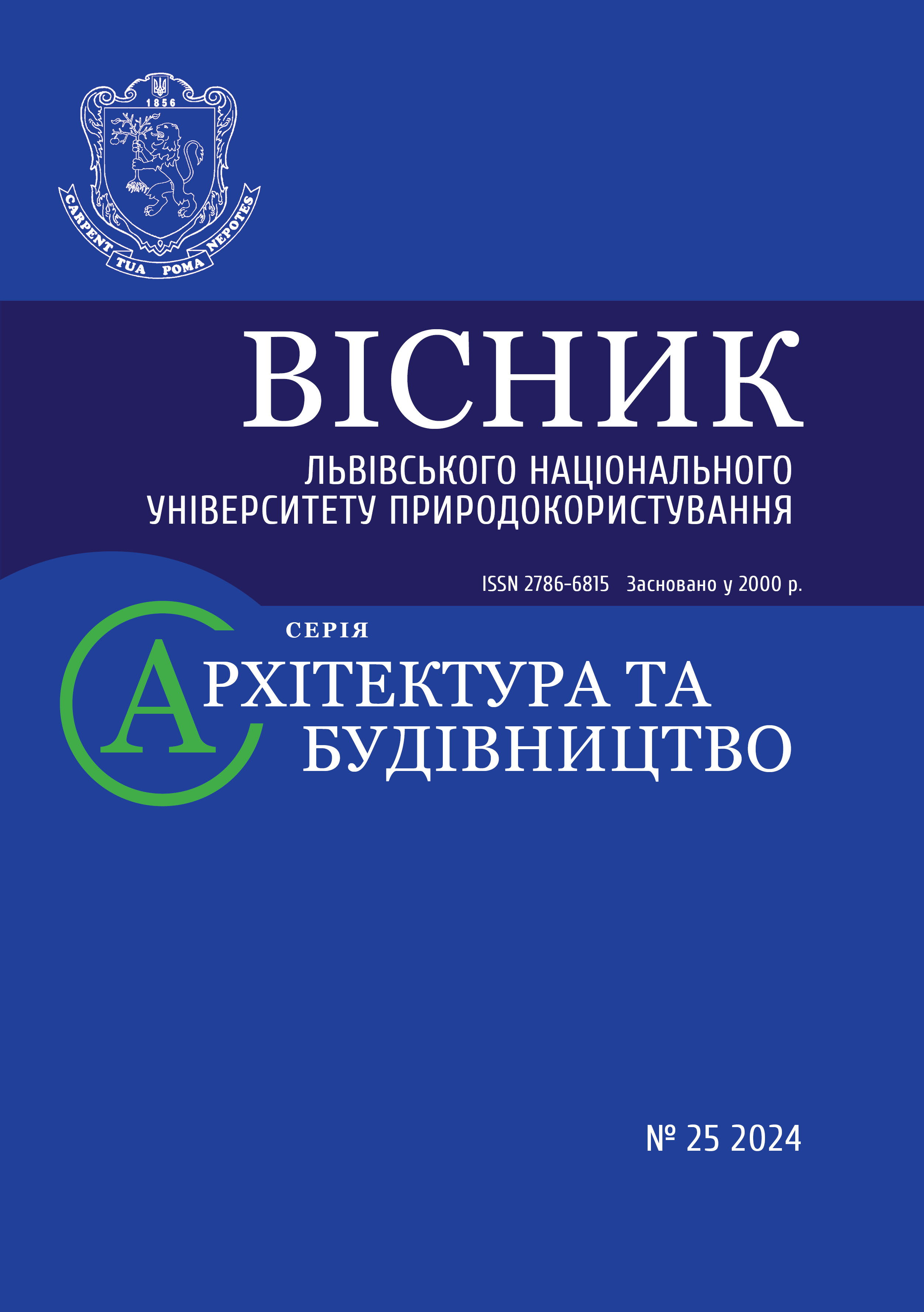SYMBIOSIS OF CONCEPTUAL AND ADAPTIVE ARCHITECTURE IN THE REVITALIZATION OF HISTORICAL HERITAGE SITES
DOI:
https://doi.org/10.31734/architecture2024.25.119Keywords:
symbiosis of conceptual and adaptive architecture methods, revitalization and adaptation of historical heritage sites to modern needs, conceptual architecture, adaptive architectureAbstract
Symbiosis is a term that has several meanings. Symbiosis is a Greek word that can mean: 1. a form of coexistence of organisms of different species; 2. a successful combination of different elements. The term symbiosis is of interest in terms of the synthesis of art, namely the form of mutually beneficial coexistence (combination) of conceptual and adaptive architecture methods in the revitalization of historical heritage sites.
Conceptual architecture as a type of creative activity is based on ideas or concepts. Concept (Latin. Conceptio – understanding) - a system of views; a single, defining idea.
Adaptive architecture adapts its form, design, and function to modern needs and operational requirements.
During the implementation of projects aimed at revitalizing Eastern European heritage monuments, the working groups of the LNEU have developed seven projects in 2023 under the Grant Agreement for the project titled "Application of the Principles of Adaptive Architecture in the Revitalization of Abandoned Architectural Monuments of Common Eastern European Heritage" (No. 101084975 – Revitalization – ERASMUS-JMO-2022-HEI-TCH-RSCH) as part of the EU Erasmus+ program. In the course of this work, the authors identified a key insight: the final outcome of these efforts - namely, the adaptation of historical buildings or complexes to meet modern needs, as well as the harmonious integration of restored architectural environments with their surrounding spaces—largely depends on the effective combination (or symbiosis) of conceptual and adaptive architecture methods in design practice.
To study and research this phenomenon, the authors applied the method of analyzing the process of implementing projects for the revitalization and adaptation of monuments of Eastern European heritage to modern needs. They analyzed literary sources on the problems of symbiosis in architecture and art.
Under the conditions of the Grant Agreement, for a more thorough study of the problems of the revitalization of monuments of Eastern European heritage, the Department of Architecture of the LNEU introduced disciplines for students of the specialty 191 "Architecture and Urban Planning" Bachelor's Degree: "Adaptive Architecture in the Design of Eco-Settlements" and Master's Degree: "Adaptive Architecture in the Revitalization of Architectural Monuments". When performing graphic works and course projects, students of the LNEU were proposed to apply the principle of a symbiosis of the methods of conceptual and adaptive architecture.
At the initial stage of the project implementation for the revitalization of historical heritage sites, it is important to develop a concept for solving the set task, to choose the correct approach. The next stage involves work on the architectural and spatial transformation of the form, changing the design and functional purpose to meet the modern needs and operational requirements of the building or a historical monument complex. This process involves the use of methods and principles of adaptive architecture. The harmonious combination (symbiosis) of these two components contributes to the effective and scientifically justified achievement of the goal - the revitalization of a historical heritage site.
The research results can be applied in the educational practice of architectural design by students-architects and used by architects in the implementation of projects for the revitalization and adaptation to modern needs of objects of architectural and historical heritage.
References
Binh Duc Nguyen, A. Simeone, A. Vande Moere. Exploring an Architectural Framework for Human-Building Interaction via a Semi-Immersive Cross-Reality Methodology. Published in IEEE/ACM International Conference on Engineering, Environmental Science. 8 March 2021. URL: https://www.semanticscholar.org/paper/Exploring-an-Architectural-Framework-for-via-a-Nguyen-Simeone/4df76ea0a6371e861e02babf452e1839ac2dca87 (Accessed December12, 2023).
Borodkina I. M., Borodkina-Viter B. Yu. Symbiosis of cultural traditions in architecture and fashion. Architectural Bulletin of KNUBA. 2015. No 5. P. 44–49.
Bosenko Ye. V. Definition of the adaptation potential of significant historical buildings as a way to preserve architectural heritage: author's abstract. dis. ... candidate of architecture: 18.00.01. Kharkiv, 2019. 24 p.
Buravchenko S. H., Splavska K. D. Principles of adaptive housing formation according to changes in the needs of residents. Theory and Practice of Design: Collection of Scientific Papers. 2020. Issue 20. Kyiv: NAU, 2020. P. 18–26.
DBN V.2.2-40:2018 Inclusiveness of buildings and structures. Kyiv: Ministry of Regional Development of Ukraine. 64 p.
DBN V.2.2-9:2018 Public buildings and structures. Kyiv: Ministry of Regional Development, Construction and Housing and Communal Services of Ukraine, 2019. 46 p.
Demydiuk Yu. V. History of the emergence and development of ideas of adaptability in architecture. International Scientific Journal "Scientific Review". 2015. No 8 (18). Kyiv, 2015. P. 81–87.
Eizenman P. Architecture as conceptual art. Harvard Art Journal. 2003/2004. No 19.
Habrel M. M. Criteria and requirements for sustainable urban development in real estate assessment and project decision-making. Current Problems of Architecture and Urban Planning. 2019. Issue 53. P. 135–147. URL: http://nbuv.gov.ua/UJRN/ (Accessed February 2, 2024).
Hnat H. O., Solovii L. S. Issues of adaptability of the layout structure of small apartments to future needs. Current Problems of Architecture and Urban Planning, 2017. Issue 48. P. 358–365. URL: http://nbuv.gov.ua/UJRN/Spam_2017_48_45 (Accessed December 2, 2023).
Hølt Bak S., Rask N., Risi S. Towards Adaptive Evolutionary Architecture. Published in EvoMUSART. 30 March 2016. Philosophy, Computer Science, Art, Engineering. URL: https://www.semanticscholar.org/paper/Towards-Adaptive-Evolutionary-Architecture-Bak-Rask/310f6ebbdfa96affc0681886de9b04a8fe52bb9d (Accessed December 14, 2023).
Kalonaris Stefano. Evolutionary Games for Audiovisual Works: Exploring the Demographic Prisoner's Dilemma. Published in EvoMUSART. 24 April 2019. Computer Science, Art, Philosophy. URL: https://www.semanticscholar.org/paper/Evolutionary-Games-for-Audiovisual-Works%3A-Exploring-Kalonaris/19ba8823ed9f14b1a0f25e9a17acaa30620b7287 (Accessed December 14, 2023).
Kiuntsli R., Stepaniuk A. Issues of adaptation of architecture of new buildings in the exterior of historical environment of the city. Problems of restoration of social infrastructure and spatial development of territories of post-war Ukraine: theses of reports of the International Scientific Conference (Dubliany-Lviv, October 27–28). LNEU, 2022. 266 p.
Kiuntsli R., Stepaniuk A. Problems of restoration of urban planning objects of historical heritage in the conditions of the post-war period. Problems of restoration of social infrastructure and spatial development of territories of post-war Ukraine: theses of reports of the International Scientific Conference (Dubliany-Lviv, October 27–28). Dubliany: LNEU, 2022. 266 p.
Kondel-Perminova N. Integration of architectural monuments and urban planning into the modern social and cultural context. Current Issues in Research, Restoration, and Preservation of Cultural Heritage. 2008. Issue 5. P. 94–111. URL: http://nbuv.gov.ua/UJRN/Spdr_2008_5_8 (Accessed February 2, 2024).
Kovalskyi V. P., Rapava D. H. Impact of revitalization on urban development. Proceedings of the 47th Scientific and Technical Conference of VNTU Divisions, Vinnytsia, March 21-23, 2018. URL: https://conferences.vntu.edu.ua/index.php/all-fbtegp/all-fbtegp2018/paper/view/5047 (Accessed January 11, 2024).
Krasnyi P. Lviv artistic environment against the idea of art symbiosis in the decoration and arrangement of sacred interiors (1730-1780). "Yi" Journal. 2013. Issue 72. URL: http://www.ji.lviv.ua/n72texts/Lvivske_mistecke_seredovysche.htm (Accessed Decemder 11, 2023).
Myronenko V. P., Demydiuk Yu. V. Prospects for the development of adaptive architecture in Ukraine. Materials of the 5th Ukrainian Scientific Conference "Vayngortiv Readings". Poltava: Divosvit, 2013. P. 178–184
Parlac V. Adaptive Architecture: Towards Resiliency in the Built Environment. URL: https://www.acsa-arch.org/proceedings/Intersections%20Proceedings/ ACSA.AIA.Inter.18/ACSA.AIA.Inter.18.4.pdf (Accessed December 02, 2023).
Schnädelbach Holger. Adaptive Architecture – A Conceptual Framework. Book. URL: https://www.researchgate.net/publication/235218510_ Adaptive_Architecture_-_A_Conceptual_Framework (Accessed December 14, 2023).
Sharovatov V. Symbiosis as a method in architectural formation at the beginning of the 20th century. Current Issues in Architecture and Urban Planning. 2023. P. 95–104. URL: https://doi.org/10.32347/2077-3455.2023.66.95-104 (Accessed December 23, 2023).
Shataliuk Yu. V. Techniques and principles of adaptive architecture formation. Science and Life: Current Trends, Integration into the World Scientific Thought: International Scientific Journal. Kyiv, 2016. P. 48–56.
Stepaniuk A. V., Kiuntsli R. V. Formative role of urban planning and spatial factors in volumetric-planning solutions of adaptive architecture in the revitalization of buildings of abandoned monuments of the Eastern European heritage. Theory and Practice of Design National Aviation University. 2023. Issue 27. P. 93–100.
Stepaniuk A. V., Kiuntsli R. V. Issues of adaptation of architecture of new buildings in the exterior of historical environment of the city. Problems of restoration of social infrastructure and spatial development of territories of post-war Ukraine: theses of reports of the International Scientific Conference (Dubliany-Lviv, October 27–28) Dubliany: LNEU, 2022. P. 169–170.
Trofymenko K. O., Kovalskyi V. P., Vozniuk I. M. Revitalization of industrial objects. Youth in Science: Research, Problems, Perspectives: Abstracts of the Ukrainian Scientific and Practical Internet Conference of Students, Postgraduates, and Young Scientists (MN-2020), Vinnytsia, May 18–29, 2020. URL: https://conferences.vntu.edu.ua/index.php/mn/mn2020/paper/view/8660 (Accessed February 1, 2024).
Tsuman K. M. Modularity as part of adaptive architecture. Current Issues in Architecture and Urban Planning. 2015. Issue 40. P. 171–176. URL: http://nbuv.gov.ua/UJRN/Spam_2015_40_28 (Accessed February 1, 2024).


